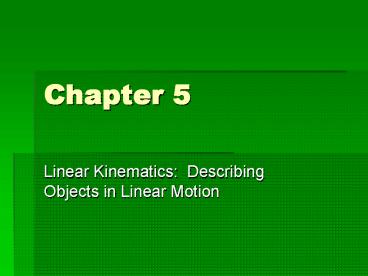Linear Kinematics: Describing Objects in Linear Motion - PowerPoint PPT Presentation
1 / 12
Title:
Linear Kinematics: Describing Objects in Linear Motion
Description:
A branch of dynamics concerned with the description of motion. ... Speedometer Readings. Velocity. V = displacement/time but includes direction. Acceleration ... – PowerPoint PPT presentation
Number of Views:172
Avg rating:5.0/5.0
Title: Linear Kinematics: Describing Objects in Linear Motion
1
Chapter 5
- Linear Kinematics Describing Objects in Linear
Motion
2
Kinematics
- A branch of dynamics concerned with the
description of motion. - Then - What is motion? The action or process of a
change in position. Must occur in SPACE and TIME.
3
Linear Motion
- Rectilinear Translation
- Curvilinear Translation
4
Angular Motion
- Rotary Motion When points on an object or a
body rotate in circles or portions of circles
about an axis.
5
Position
- Defined as LOCATION IN SPACE. Defined through
spatial orientation x, y and z in this course.
Do not worry about the coordinate system used in
our text.
6
Distance
- A measure of the length of the path followed by
the object whose motion is being described-from
initial position to final position.
7
Displacement
- The straight line distance in a specific
direction form initial position to final
position. Vector Quantity It has magnitude and
direction. - dposition (final)-position (initial)
- May need to find resultant displacement between
horizontal and vertical motion.
8
Speed/Velocity
- Not the same-Velocity is a vector quantity. It
has magnitude and direction. - Speed is the rate of motion-Velocity is the rate
of motion in a specific direction. - Average speed distance traveled/t
9
Instantaneous Speed
- The speed of an object at a specific instant of
time. Speedometer Readings.
10
Velocity
- V displacement/time but includes direction
11
Acceleration
- When an object speeds up, slows down, starts,
stops or changes direction, it is accelerating. - Average acceleration velocity (final)-velocity
(initial)/ time
12
Constant Velocity/Zero Acceleration
- Velocity is not changing therefore the system is
not accelerating. Thus zero acceleration.
Cruise control.

